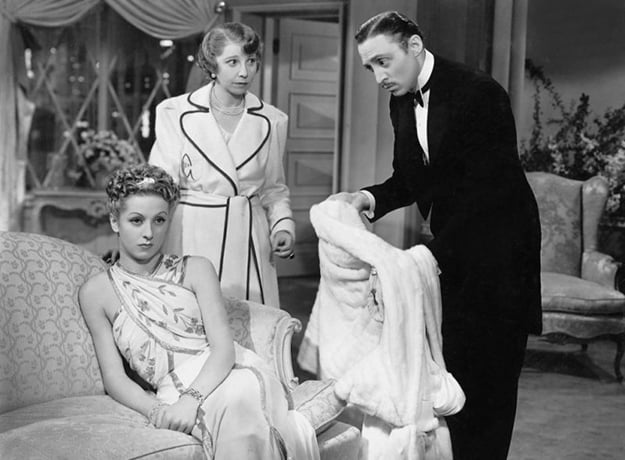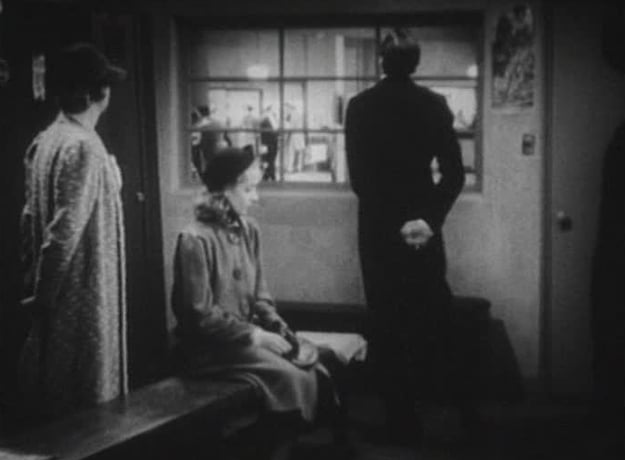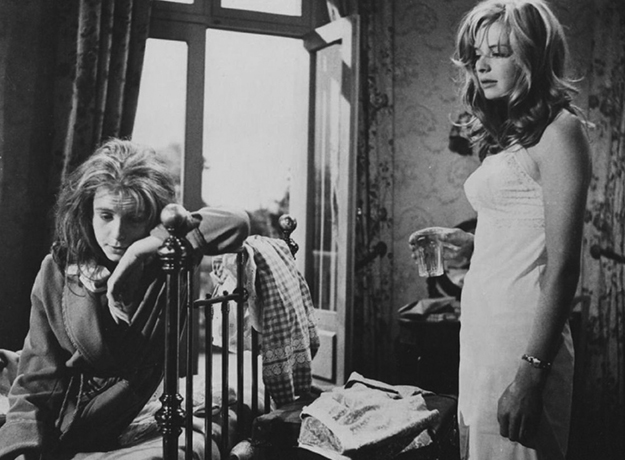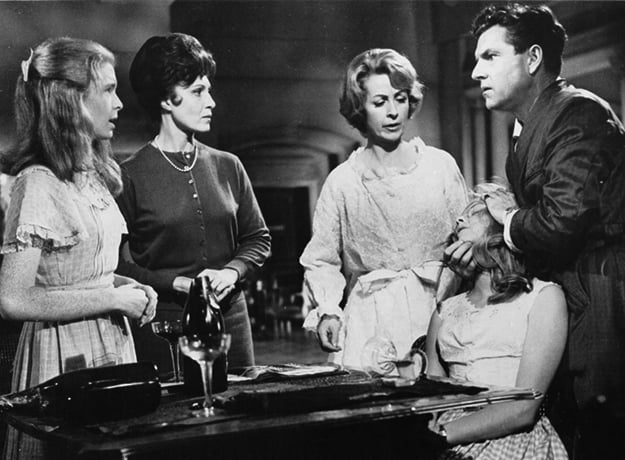TCM Diary: Danielle Darrieux

The Rage of Paris
Before MM (Marilyn Monroe) and BB (Brigitte Bardot), there was DD. Danielle Darrieux, the French actress and singer who celebrates her 100th birthday on May 1, was already known to her fans the world over for her coupled consonants and her singular confidence.
Unlike most branded stars whose appeal can be captured in one well-chosen adjective, the multifaceted Darrieux would require the whole thesaurus. All accounts must begin with the self-possession that’s sparked every one of her performances since her debut at age 14 in 1931’s Le Bal. Not for nothing is the actress’s full name Danielle Yvonne Marie Antoinette Darrieux: she commands the screen as if born to rule, though her subjects would never think of revolting. Her stardom was solidified while still in her teens by the romantic tearjerker Mayerling (1936, her first pairing with Charles Boyer). And so she was persuaded to try her luck in Hollywood, signing a contract with Universal that yielded just one film: a made-to-order soufflé called The Rage of Paris (1938).
Two years after launching adolescent songstress Deanna Durbin into the firmament with her star-making vehicle Three Smart Girls, director Henry Koster was charged with grooming Darrieux for similar success with The Rage of Paris. The image that Koster and the studio devised for her is as fascinating as it is anomalous. Bypassing the sphinxlike mystique that tended to come with the territory for European émigrés (Garbo, Hedy Lamarr), Darrieux was presented as a sort of Gallic Jean Arthur, winsomely klutzy and playfully daft. Humiliations are visited on Darrieux’s character, French chorine Nicole de Cortillion, even before the main plot commences. Thinking she has a lead on a modeling job, Nicole starts to undress in the office of playboy Jim Trevor (Douglas Fairbanks Jr.), naïvely asking the perplexed Jim for the “draps” she was told she’d be wearing. (It’s a testament to Darrieux’s charm that her frequent mangling of the synonym for curtains and other English vocabulary remains mildly amusing throughout.)

The Rage of Paris
Clocking an agreeable 78 minutes, The Rage of Paris spins a vintage Depression-era yarn. Nicole’s wisecracking friend (Helen Broderick, a sardonic joy) gets her ex-flame (the ever-excitable Mischa Auer), a waiter saving up to buy his own restaurant, to set Nicole up with rented furs so she can attract a millionaire husband. The trio set their sights on Bill Duncan (Louis Hayward), who “owns half of Canada.” Bill also happens to be best friends with Jim Trevor—who spends the balance of the film trying to expose Nicole as a gold digger, while (to the shock of anyone who has never seen a romantic comedy) falling for her himself.
The man-trap premise and its underlying philosophy (“The only career for a woman is marriage,” Broderick instructs) would seem to make the film a museum piece, but Darrieux is both too crafty and too winningly vulnerable to get swallowed up by plot machinations. Her eyebrows—perfect semicircles—arch in astonishment, gratification, and fear, and outline the sparkling orbs that prove her most valuable asset. They are central to the genuine hurt she projects when Jim calls her “cheap,” just as they glisten with appreciation moments later when she tells him Bill is lucky to have him as a friend. The Rage of Paris is a most unusual rom-com in that its hero spends most of the runtime resenting its heroine, who is so touched by his fraternal loyalty that she falls for him, even as his motives run perpendicular to hers. And it’s even more unusual in that Jim is right to doubt her—she is every inch the fraud he believes her to be. Once again, Darrieux’s charisma saves the day.
Though the film was well-received, its star would soon distance herself from this studio-crafted persona—which is something of a loss, given the paucity of screwball comediennes and her obvious dexterity at the form. As the sole surviving document of DD playing ditzy, Rage of Paris offers a showcase of skills she would seldom exercise again: slapstick (her quarterback rush at Jim’s butler, instructed to block her exit from his apartment), vocal gymnastics (she chortles like a kookaburra when she’s tickled), and even improvisation. Nicole addresses herself in French when she’s agitated, quickly and under her breath, most of which is lost on Anglophone ears (though her description of Jim as cochon can’t be missed).

Loss of Innocence
Darrieux’s most strikingly spontaneous moment occurs when Nicole awakens in her posh new surroundings and begins dictating her breakfast order to Broderick. Gleefully writhing on the bed and giggling at the opulence of it all, she calls for “some honeydew melon, and some toast with lots of butter . . . and then I want some bacon and a jelly donut!” Rather amazingly, her bridge from butter to bacon contains not one “and then”, but six of them, which could hardly have been in the script. Koster must have instructed Darrieux to display unbridled bliss, which she does with infectious artlessness. Quel dommage that she hasn’t done it more often.
Instead the actress returned to Paris, where she remained for the duration of World War II. The early 1950s brought three collaborations with Max Ophüls for which she is likely best known: La Ronde, Le Plaisir, and most particularly, The Earrings of Madame de…, in which she offers a performance of breathtaking complexity as Boyer’s faithless wife, in what Andrew Sarris called “the most perfect film ever made.” Darrieux has spent most of her nearly nine-decade career in France—appearing in films for Chabrol, Demy, and Téchiné—with latter-day highlights including François Ozon’s 8 Women (2002, her fourth turn as Catherine Deneuve’s mother) and a touching voice role in Marjane Satrapi’s animated memoir Persepolis (2007, her fifth). But on occasion she’s been lured back to the U.S., to play the widowed countess in Joseph L. Mankiewicz’s WWII thriller 5 Fingers (1952), or the U.K., where she brought tremendous nuance to the supporting role of the callous hotelier in Lewis Gilbert’s Loss of Innocence (1961).
Loss of Innocence was based on the novel The Greengage Summer by Rumer Godden, the author of Black Narcissus, which explored similar themes of sexual rivalry and isolation. The film concerns itself with the maturation of Joss (a sensitive Susannah York), a 16-year-old English girl stranded at a château in Épernay, France with her three younger siblings after their mother takes ill. As the summer wears on, she learns how to harness her power over adoring men, and is herself captivated by the suave but mysterious Eliot (Kenneth More), an ex-serviceman involved with the estate’s steely proprietress, Madame Zizi (Darrieux).

Loss of Innocence
On paper Zizi is a peripheral character—the romantic adversary who stands not a chance, but who won’t surrender without a fight. Entrusted to Darrieux, whose pairings with Ophüls made her an expert delineator of misplaced love, she emerges as the film’s locus of tragedy. “The river brought you here. I hope it never takes you away,” she implores Eliot early on, conveying Zizi’s dependency on her lover and laying the table for their calamitous dissolution. Eliot is plainly a fugitive from the law, and whether his feelings for Zizi are genuine, he’s using her hotel as a hideout, forcing her to turn away all guests but the children. Her suspicions that Eliot is exploiting her for sanctuary and hollow diversion are fanned by the sharp-tongued concierge, Madame Corbet (Claude Nollier)—who, it is implied with startling frankness, harbors feelings for her employer, making for a most unusual and volatile sexual polygon.
Cutting a formidable figure in her dazzling gowns and jewelry, Madame Zizi nevertheless fails to hide her insecurities once the radiant, self-assured Joss makes her interest in Eliot known. The children observe that the Madame’s blonde hair is dyed and her middle age inescapable, with wartime atrocities adding further years to her countenance. (Ever the survivor, she has the walls of the bar splashed with red paint, which paying customers are told is blood from the conflict.) As Eliot wines and dines the young guests—it seems the drinking age in the Champagne region is “old enough to hold a glass”—Zizi whines and pines for the lover she knows she’s losing. She tells Corbet that there’s nothing left for her but Eliot.
Darrieux (miles away from the sprightly Nicole of her youth) etches a scalding portrait of a bitter woman on the cusp of losing her lone source of happiness. Zizi calls Joss a “little slut,” tosses champagne in her face and accuses her of bringing evil into her house, but she understands too well that the evil is her own jealousy, warping her into a territorial shrew. She sees in Joss a younger version of herself, and grasps that Eliot’s affection would be lost to her own possessiveness sooner than to her rival. Everyone in her midst is mired in unrequited love, no one more than she, and Darrieux wrings every drop of pathos from the torture of Zizi’s situation without relaxing her imperious front. Here the rage is not of Paris, but against the dying of the light.
The Rage of Paris and Loss of Innocence air May 1 on Turner Classic Movies.
Steven Mears received his MA in film from Columbia University, where he wrote a thesis on depictions of old age in American cinema.







